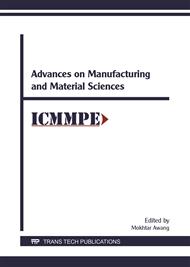[1]
Honarvar Nazari, M., S. Allahkaram and M. Kermani. The effects of temperature and pH on the characteristics of corrosion product in CO2 corrosion of grade X70 steel. Materials & Design 31(2010) 3559-3563.
DOI: 10.1016/j.matdes.2010.01.038
Google Scholar
[2]
Nordsveen, M., S. Nešic, R. Nyborg and A. Stangeland. A mechanistic model for carbon dioxide corrosion of mild steel in the presence of protective iron carbonate films-Part 1: Theory and verification. Corrosion 59 (2003) 443-456.
DOI: 10.5006/1.3277576
Google Scholar
[3]
George, K. and S. Nešic. Investigation of carbon dioxide corrosion of mild steel in the presence of acetic acid-Part 1: Basic mechanisms. Corrosion 63 (2007) 178-186.
DOI: 10.5006/1.3278342
Google Scholar
[4]
Ezuber, H. M. Influence of temperature and thiosulfate on the corrosion behavior of steel in chloride solutions saturated in CO2. Materials & Design 30 (2009) 3420-3427.
DOI: 10.1016/j.matdes.2009.03.028
Google Scholar
[5]
Saeid Kakooei, M. C. I., Bambang Ari-Wahjoedi. Surface pH measurement during CO2 corrosion by a microelectrode pH probe. Advanced Materials Research, 1133 (2016) 381-385.
DOI: 10.4028/www.scientific.net/amr.1133.381
Google Scholar
[6]
Dugstad, A. Mechanism of protective film formation during CO2 corrosion of carbon steel. CORROSION 98. (1998) Houstan, Texas. paper no. 31.
Google Scholar
[7]
Nesic, S., R. Nyborg, M. Nordsveen and A. Stangeland. Mechanistic Modeling for CO2 Corrosion with Protective Iron Carbonate Films. CORROSION 2001. (2001).
DOI: 10.5006/1.3277576
Google Scholar
[8]
Farelas, F., B. Brown and S. Nesic, Iron Carbide and its Influence on the Formation of Protective Iron Carbonate in CO2 Corrosion of Mild Steel. NACE. (2013). Houston, Texas, NACE International.
Google Scholar
[9]
Nešić, S. Key issues related to modelling of internal corrosion of oil and gas pipelines–A review. Corrosion Science 49 (2007) 4308-4338.
DOI: 10.1016/j.corsci.2007.06.006
Google Scholar
[10]
Das, G. and A. Khanna. Corrosion behaviour of pipeline steel in CO2 environment. Trans. Indian Inst. Met 57 (2004) 277-281.
Google Scholar
[11]
Kakooei, S., M. C. Ismail and B. A. Wahjoedi. Electrochemical Study of Iridium Oxide Coating on Stainless Steel Substrate. " Int. J. Electrochem. Sci 8(3) (2013) 3290-3301.
DOI: 10.1016/s1452-3981(23)14390-2
Google Scholar


